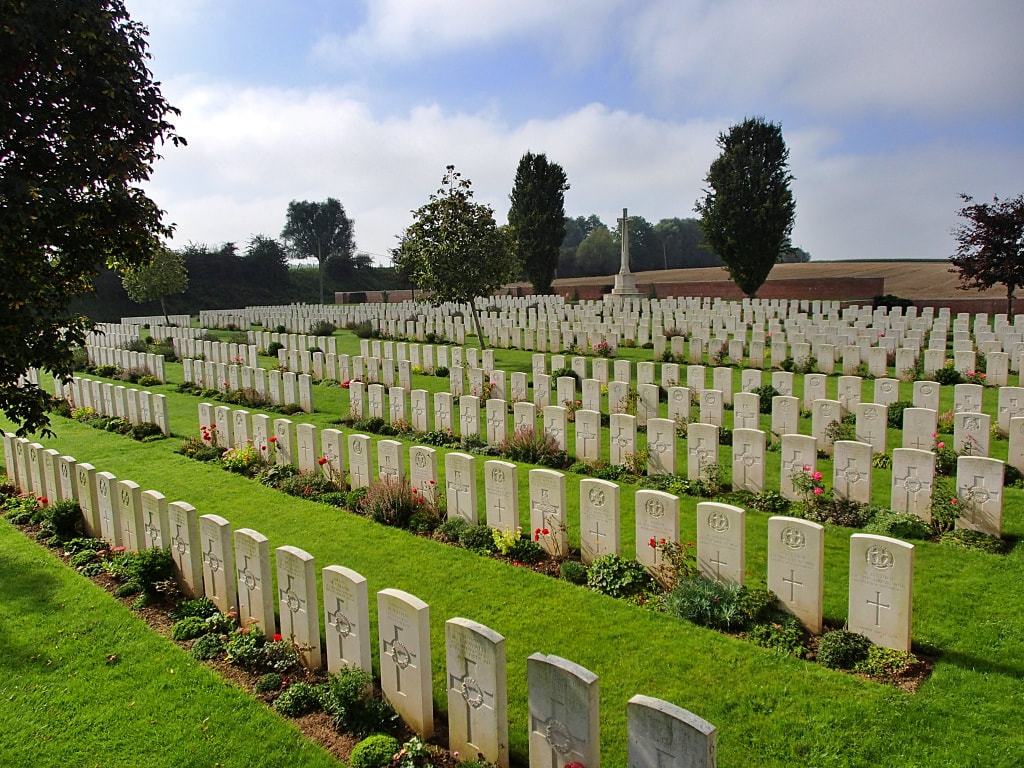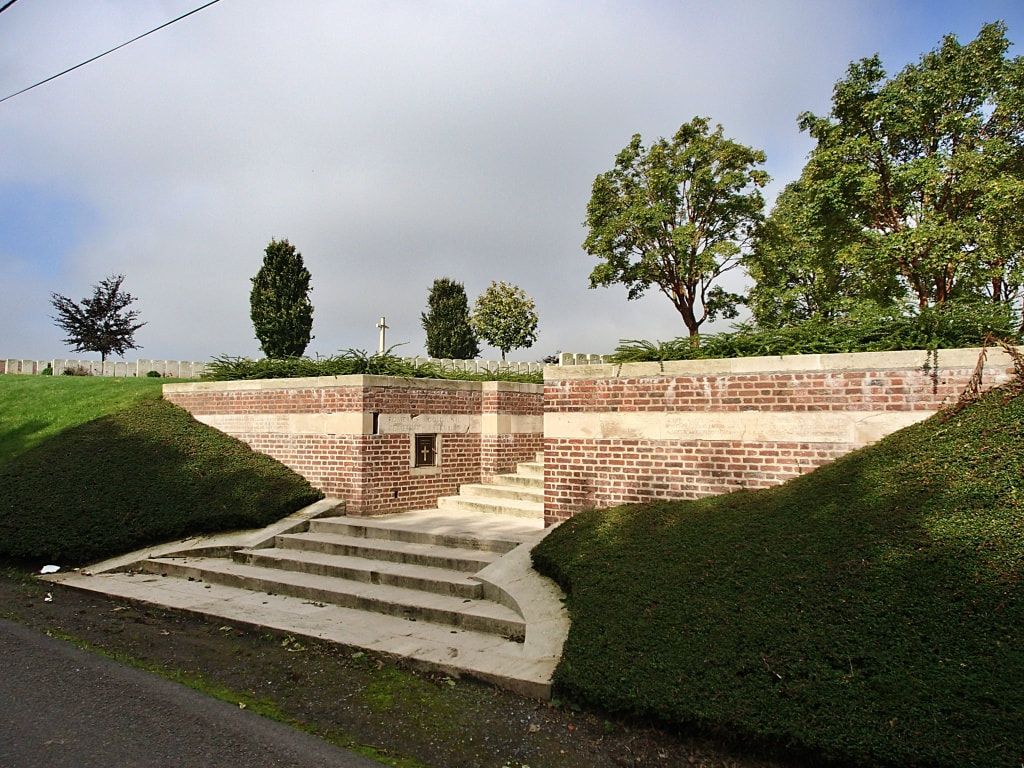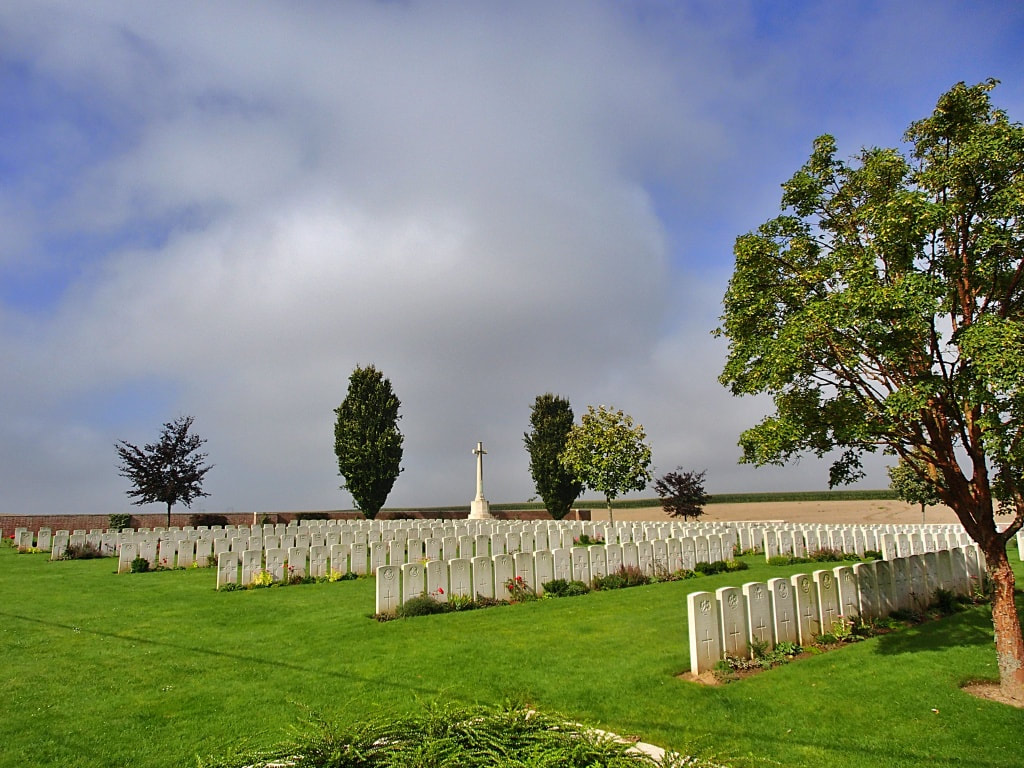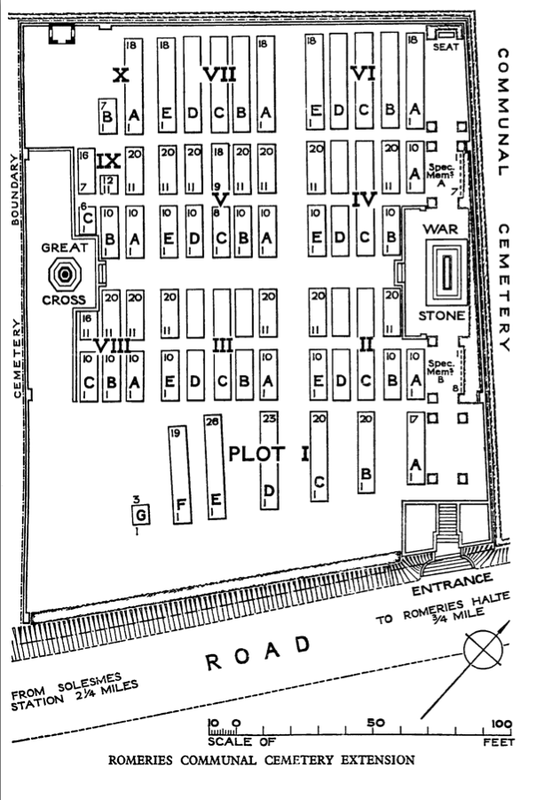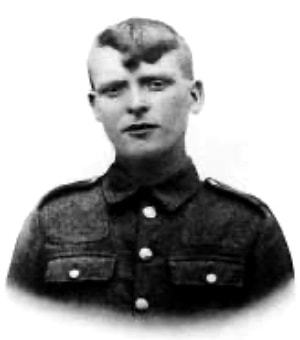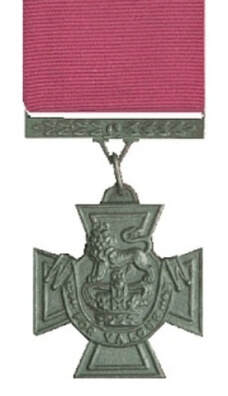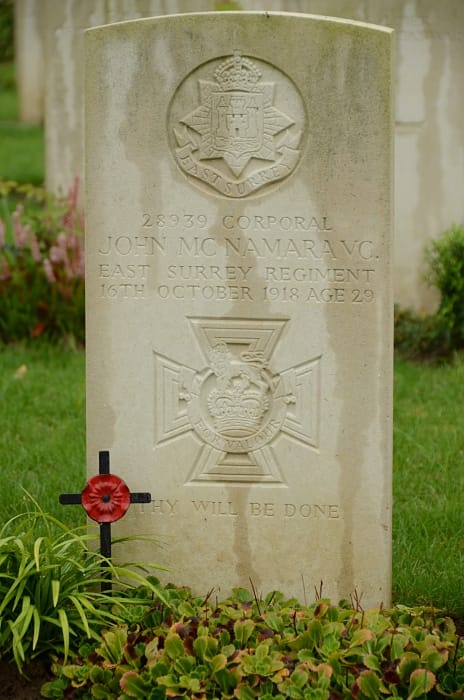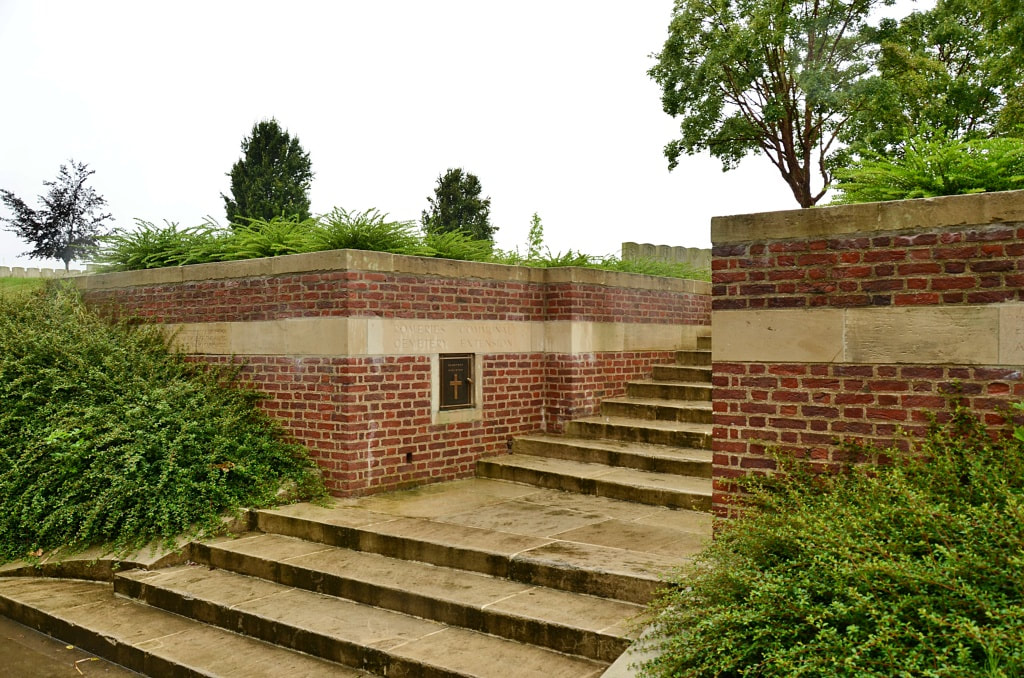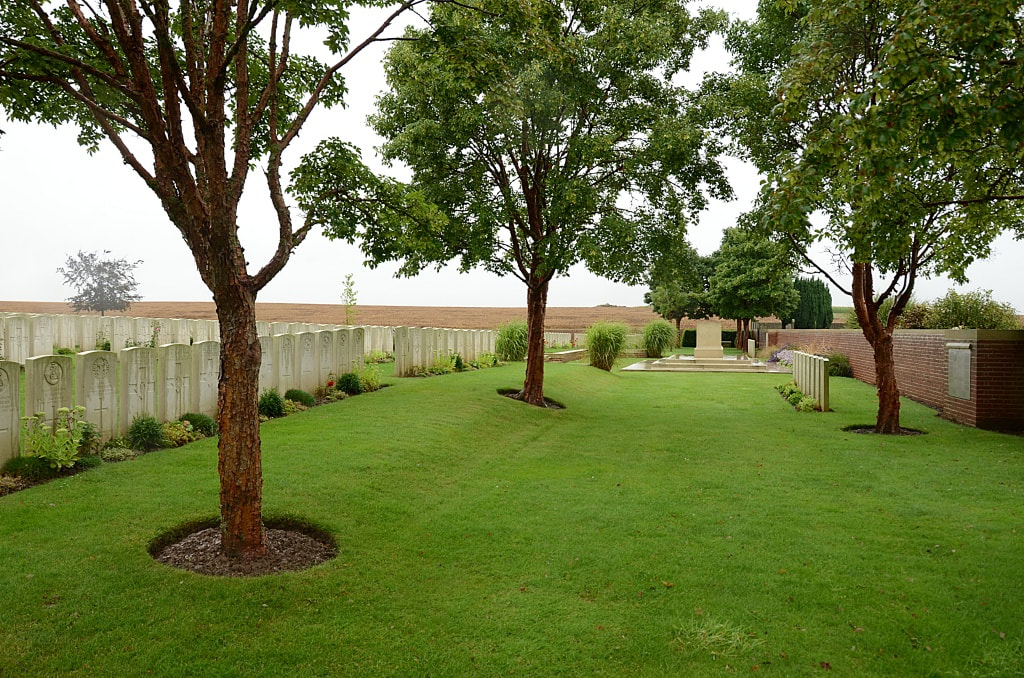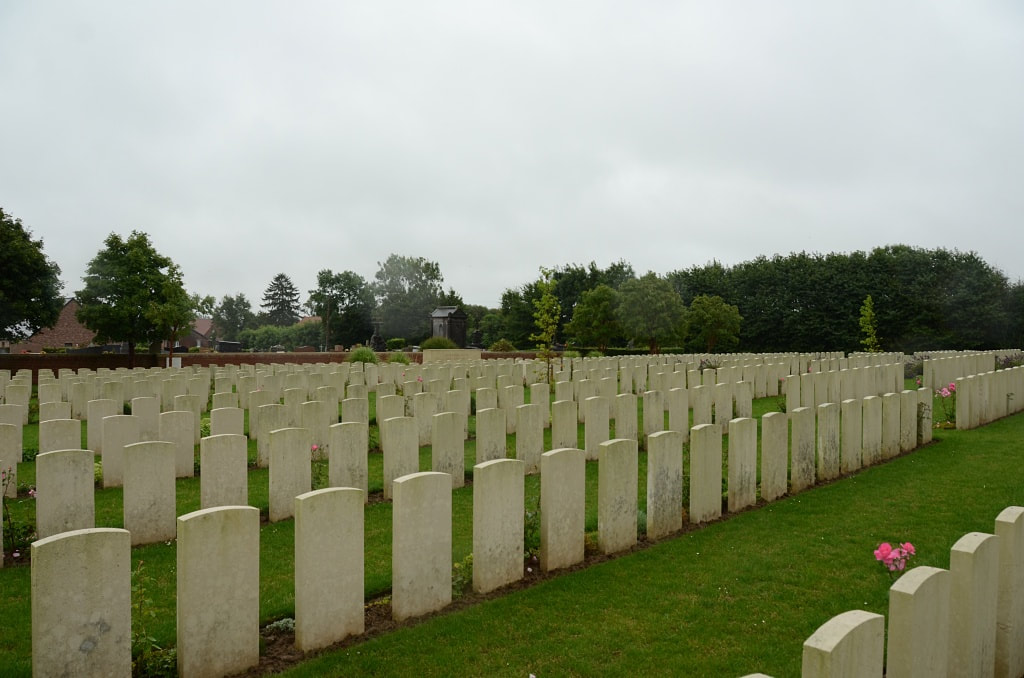ROMERIES COMMUNAL CEMETERY EXTENSION
Nord
France
GPS Coordinates: Latitude: 50.20073, Longitude: 3.52343
Location Information
Romeries is a village approximately 16 kilometres south of Valenciennes and 4 kilometres north-east of Solemes. The Communal Cemetery is on the west side of the village on the north side of the road to Solesmes.
Visiting Information
Wheelchair access to this site is possible, but may be by alternative entrance.
Historical Information
Part of the II Corps retired through this area during the Retreat from Mons in August 1914, and in October 1918, Commonwealth forces returned during the Advance to Victory.
Briastre was captured on 10 October 1918, Belle Vue Farm on 20 October, Romeries itself and Beaudignies on 23 October and Englefontaine on 26 October. The Battle of the Sambre, the last great action of the war, carried the front forward into Belgium and ended with the Armistice. Romeries Communal Cemetery Extension is one of the burial grounds of those who died between these dates.
The original extension is Plot I, made by the 3rd and New Zealand Divisions, and containing 128 graves. The remaining plots were made after the Armistice when graves were brought in from isolated positions on the battlefield, including (in Plot X) a few graves of 25 August 1914, and from small cemeteries, including:-
BRIASTRE-SOLESMES ROAD MILITARY CEMETERY, BRIASTRE (Nord), was used by the 37th Division and the 1st Wellington Regiment (New Zealand) from the 11th to the 16th October, 1918. It contained the graves of 25 soldiers from the United Kingdom (12 of the 4th Middlesex) and 11 from New Zealand. It was about 800 metres South-East of Briastre, across the Selle.
BRIASTRE CHURCHYARD contained the grave of one New Zealand soldier.
BELLE VUE FARM CEMETERY, BRIASTRE, was 200 metres South of the Farm, which was almost immediately East of Briastre, across the Selle. It contained the graves of 16 soldiers of the 4th Middlesex who fell on the 10th October.
BEAUDIGNIES CHURCHYARD (Nord) contained the graves of five New Zealand soldiers who fell on the 4th November.
ENGLEFONTAINE GERMAN CEMETERY contained the graves of three soldiers from the United Kingdom who fell on the 26th and 27th October.
GRAND GAY FARM CEMETERY, LOUVIGNIES-QUESNOY (Nord), was nearly 1.6 kilometres South of Louvignies. There were buried in it 37 soldiers from the United Kingdom, 24 of whom belonged to the 9th Duke of Wellington's.
SALESCHES CHURCHYARD (Nord) contained the graves of three soldiers from the United Kingdom who fell on the 25th and 29th October.
ST. PYTHON COMMUNAL CEMETERY EXTENSION was made by the 2nd Division. It contained the graves of 23 soldiers from the United Kingdom, two from New Zealand, and one from Canada, who fell between the 27th October and the 8th November.
There are now 833 burials and commemorations of the First World War in the extension. 129 of the burials are unidentified but there are special memorials to 15 casualties believed to be buried among them.
Total Burials: 832.
Identified Casualties: United Kingdom 596, New Zealand 106, Canada 1. Total 703.
Unidentified Casualties: United Kingdom 75, New Zealand 6, Unknown 48. Total 129.
The extension was designed by Charles Holden and William Harrison Cowlishaw
28939 Corporal John McNamara, V. C.
9th Bn. East Surrey Regiment
16th October 1918, aged 29.
Plot IV. D. 17.
Son of John and Margaret McNamara; husband of Mary Ann Mitchell (formerly McNamara), of 82, Stone Row, School Lane, Preston.
His headstone bears the inscription "Thy Will Be Done"
Citation:
An extract from the London Gazette, dated 12th Nov., 1918, records the following:-"For conspicuous bravery, initiative, and devotion to duty. When operating a telephone in evacuated enemy trenches occupied by his battalion, Cpl. McNamara realised that a determined enemy counter-attack was gaining ground. Rushing to join the nearest post, he made the most effective use of a revolver taken from a wounded officer. Then seizing a Lewis gun he continued to fire it till it jammed. By this time he was alone in the post. Having destroyed his telephone, he joined the nearest post, and again displayed great courage and initiative in maintaining Lewis gun fire until reinforcements arrived. It was undoubtedly due to the magnificent courage and determination of Pte. McNamara that the other posts were enabled to hold on, and his fine example of devotion is worthy of the highest praise."
Images in this gallery © Johan Pauwels
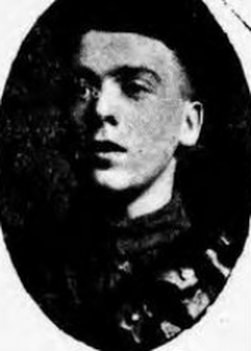
45948 Rifleman
C. Lucas
13th Bn. Rifle Brigade
22nd October 1918, aged 19.
Plot. V. A. 19.
Son of Arthur John and Harriet Elizabeth Lucas, of 74, New St., Cambridge.
C. Lucas
13th Bn. Rifle Brigade
22nd October 1918, aged 19.
Plot. V. A. 19.
Son of Arthur John and Harriet Elizabeth Lucas, of 74, New St., Cambridge.
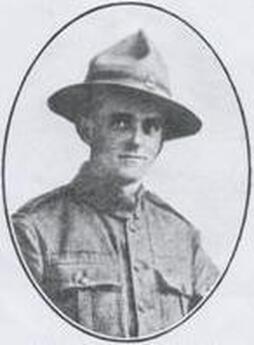
23/233 Corporal
Alexander MacLachlan
1st Battalion, 3rd New Zealand Rifle Brigade
Killed in action 4th November 1918, aged 28.
Plot IX. A. 19.
Son of Emily Keighley (formerly MacLachlan), of Alston Hall Villa, Grimsargh, Preston, England, and the late John MacLachlan.
Emigrated to New Zealand some years before the War. Prevented from enlisting by a work agreement, he joined up in May 1915. On Christmas Day 1915 he was in action against Turkish-led Arabs in Egypt. Took part in the Somme offensive in France in 1916 and went over the top when tanks were first used. June 1917 was hit by shrapnel at Battle of Messines and returned to England and revisited the College. He was killed in almost the last offensive of the War. His officer wrote in a letter, “(He) was the most popular and capable NCO in “A” Company. I had reason to bless his cheerful disposition.” Originally buried “…in a little triangular copse alongside the railway line just south of Le Quesnoy…” (Officer’s letter.)
Alexander MacLachlan
1st Battalion, 3rd New Zealand Rifle Brigade
Killed in action 4th November 1918, aged 28.
Plot IX. A. 19.
Son of Emily Keighley (formerly MacLachlan), of Alston Hall Villa, Grimsargh, Preston, England, and the late John MacLachlan.
Emigrated to New Zealand some years before the War. Prevented from enlisting by a work agreement, he joined up in May 1915. On Christmas Day 1915 he was in action against Turkish-led Arabs in Egypt. Took part in the Somme offensive in France in 1916 and went over the top when tanks were first used. June 1917 was hit by shrapnel at Battle of Messines and returned to England and revisited the College. He was killed in almost the last offensive of the War. His officer wrote in a letter, “(He) was the most popular and capable NCO in “A” Company. I had reason to bless his cheerful disposition.” Originally buried “…in a little triangular copse alongside the railway line just south of Le Quesnoy…” (Officer’s letter.)
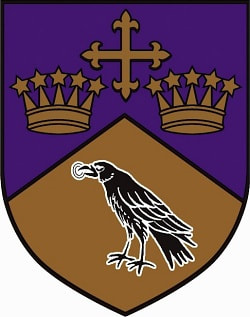
67578 Private
John Norval Robertson
2nd Bn. Auckland Regiment, N.Z.E.F.
11th October 1918, aged 25.
Plot II. A. 3.
The information below supplied by 'The Ellesmerian Club', the alumni organisation for Ellesmere College where John was a pupil.
John Norval Robertson
2nd Bn. Auckland Regiment, N.Z.E.F.
11th October 1918, aged 25.
Plot II. A. 3.
The information below supplied by 'The Ellesmerian Club', the alumni organisation for Ellesmere College where John was a pupil.
John Norval Robertson, who was born on 13th January 1893, was one of nineteen new entrants who were admitted to Ellesmere College in January 1906. Of those who entered that term, five would make the ultimate sacrifice in the Great War. Both John’s parents had died in the 1890s and, at the time of his enrolment at Ellesmere, he was in the care of his guardian. Charles James Stark Stoddart, of Hyndland Gardens, Glasgow. At that time, it was quite unusual for a pupil at Ellesmere to come from as far afield.
During his five terms at the college, The Ellesmerian makes only two references to his sporting prowess and that was to record that when he represented the ‘Heywood’ dormitory in the inter-dormitory cricket competition he scored ‘0’ in both innings! College records also show that he enlisted in the Officer Training Corps, as most boys did.
After Ellesmere, John’s life and career is vague, to say the least. By April 1917, he had lived in New Zealand for five and a half years and it is quite possible that he arrived there via America for his name can be found only on a vessel heading in that direction. His elder brother, James, had also determined to seek a new life in the southern hemisphere. In New Zealand, John found work as a general labourer for Wittome Stevenson of Auckland and soon settled down, marrying Clarice Mary Green on 24th August 1915. Their daughter, Jean Naomi, was born on 7th December of that year.
John enlisted in the New Zealand Expeditionary Force on 30th April 1917 and became Private Robertson, Service No. 67578 in the 35th Reinforcements. On his Attestation Papers, he was described as 5 feet 5 inches tall (1.62m), weighed 116 pounds (53 kg) and was of a ‘Dark’ complexion. On the documents, he stated that his previous military experience was with the “Ellesmere Rifles”. Whilst it might be assumed he was referring to his experience in the O.T.C at the college, he was, in fact, referring to the Territorial Unit he was attached to near Christchurch on the South Island.
On 8th October 1917, he was at Featherston Camp, North Island – it would be interesting to know if he ever met up with another Ellesmerian, Donald Parker, who was posted to the camp about the same time. A month later he was posted to ‘A’ Company, 35th Battalion, NZEF.
On 2nd March 1918 John embarked at Wellington. His initial destination, Suez, was reached five weeks later and his unit was based at the Australian Camp there for three weeks before he undertook a further sea voyage to Southampton.
On 15th May his unit, described as a ‘composite battalion’ disembarked at Southampton and made their way to Durrington, one of the many camps around Larkhill on Salisbury Plain. On 6th July, he was posted to Sling Camp and taken on strength by the 3rd (Reserve) Battalion, the Auckland Regiment.
For reasons that will probably never be known, John ‘absented himself’ for a few hours at the end of the month – this transgression cost him five days “confined to barracks” and a day’s pay.
The end of September saw him preparing for another, albeit shorter, sea voyage. He marched out of Sling Camp on 10th September and marched into the vast base depot at Etaples three days later. Three days later he joined his unit, the 2nd Battalion, the Auckland regiment, “in the field”.
On 11th October, after he had been at the front in the trenches for just twenty-nine days and a month before the signing of the Armistice, he was reported killed in action. He was buried in the Romeries Communal Cemetery Extension.
His British War and Victory Medals, Plaque and Scroll were sent in 1921 to his widow, Clarice.
During his five terms at the college, The Ellesmerian makes only two references to his sporting prowess and that was to record that when he represented the ‘Heywood’ dormitory in the inter-dormitory cricket competition he scored ‘0’ in both innings! College records also show that he enlisted in the Officer Training Corps, as most boys did.
After Ellesmere, John’s life and career is vague, to say the least. By April 1917, he had lived in New Zealand for five and a half years and it is quite possible that he arrived there via America for his name can be found only on a vessel heading in that direction. His elder brother, James, had also determined to seek a new life in the southern hemisphere. In New Zealand, John found work as a general labourer for Wittome Stevenson of Auckland and soon settled down, marrying Clarice Mary Green on 24th August 1915. Their daughter, Jean Naomi, was born on 7th December of that year.
John enlisted in the New Zealand Expeditionary Force on 30th April 1917 and became Private Robertson, Service No. 67578 in the 35th Reinforcements. On his Attestation Papers, he was described as 5 feet 5 inches tall (1.62m), weighed 116 pounds (53 kg) and was of a ‘Dark’ complexion. On the documents, he stated that his previous military experience was with the “Ellesmere Rifles”. Whilst it might be assumed he was referring to his experience in the O.T.C at the college, he was, in fact, referring to the Territorial Unit he was attached to near Christchurch on the South Island.
On 8th October 1917, he was at Featherston Camp, North Island – it would be interesting to know if he ever met up with another Ellesmerian, Donald Parker, who was posted to the camp about the same time. A month later he was posted to ‘A’ Company, 35th Battalion, NZEF.
On 2nd March 1918 John embarked at Wellington. His initial destination, Suez, was reached five weeks later and his unit was based at the Australian Camp there for three weeks before he undertook a further sea voyage to Southampton.
On 15th May his unit, described as a ‘composite battalion’ disembarked at Southampton and made their way to Durrington, one of the many camps around Larkhill on Salisbury Plain. On 6th July, he was posted to Sling Camp and taken on strength by the 3rd (Reserve) Battalion, the Auckland Regiment.
For reasons that will probably never be known, John ‘absented himself’ for a few hours at the end of the month – this transgression cost him five days “confined to barracks” and a day’s pay.
The end of September saw him preparing for another, albeit shorter, sea voyage. He marched out of Sling Camp on 10th September and marched into the vast base depot at Etaples three days later. Three days later he joined his unit, the 2nd Battalion, the Auckland regiment, “in the field”.
On 11th October, after he had been at the front in the trenches for just twenty-nine days and a month before the signing of the Armistice, he was reported killed in action. He was buried in the Romeries Communal Cemetery Extension.
His British War and Victory Medals, Plaque and Scroll were sent in 1921 to his widow, Clarice.
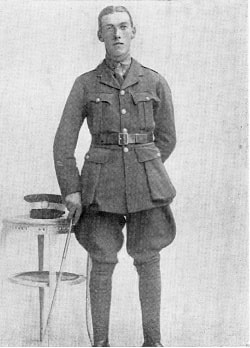
26485 Corporal
Tudor Ceitho Worthington
10th Bn. South Wales Borderers
28th October 1918.
Plot V. B. 15.
The information below supplied by 'The Ellesmerian Club', the alumni organisation for Ellesmere College where Tudor was a pupil.
Tudor Ceitho Worthington
10th Bn. South Wales Borderers
28th October 1918.
Plot V. B. 15.
The information below supplied by 'The Ellesmerian Club', the alumni organisation for Ellesmere College where Tudor was a pupil.
Tudor Ceitho Worthington was the elder of two brothers who were admitted to Ellesmere College on 17thSeptember 1909. He had previously been educated at Llangeitho British School from where he progressed to Llandovery College. On arrival in north Shropshire Tudor and his brother, Alun Trevor, were allocated to the ‘Woodard’ dormitory under the guidance of Mr. C. E. Andrews, himself an Old Ellesmerian.
Tudor introduced himself gradually into life at Ellesmere. The first mention was his keeping goal for his dormitory in his first term. After this there is silence until he played dormitory cricket in 1912, after which he started to make his presence felt on the sports field.
He became goalkeeper for the 2nd XI football team where he was said to be “a satisfactory custodian, though he was at a disadvantage owing to the greasy nature of the ball” in the game against Newport Grammar School. He received glowing reports throughout this season for his skill in goal. He started to play for the 1st XI in the following year and was awarded his 2nd XI Football colours.
He continued to represent his dormitory in various sports and was appointed captain of the newly formed 1stXV rugby squad. The team had mixed fortunes. In the end of
Season review, it was said that Tudor had “a difficult task and was not a good leader”. However, he had some leadership qualities as in the autumn of 1913 he was promoted Lance-Corporal in the Officer Training Corps and appointed Prefect.
Tudor came from a religious background as his father was a clergyman of the Church of England, incumbent in Llangeitho, Cardiganshire. His mother, Mary was some nineteen years younger than her husband.
Private Worthington, Service No: 26485, served with the South Wales Borderers having enlisted at Lampeter, some five miles south of Llangeitho. He was promoted to Corporal and saw action in some of the fiercest actions of the war.
He enjoyed a period of leave in April but, just three months later, in July 1916, ‘The Borderers’ were fighting at Mametz Wood on the Somme.
The following year his regiment was involved in the battle of Passchendaele, around Pilckem Ridge. The college’s Roll of Honour records that he and seven others were sheltering in a shell hole when a shell burst killed the others but left Tudor without a mark.
After spending another winter in Flanders, the great German spring assault (the Michael Offensive) of 1918, found the regiment at Arras and it was involved in the battles of Dorcourt-Queant and Epehy.
After the breaking of the Hindenburg Line, the Division fought in the battle of Selle during which Tudor was killed on 28th October 1918 at Englefontaine. He was within fourteen days of surviving the war.
Tudor was buried at the Romeries Communal Cemetery Extension which lies due south of Valenciennes and his sacrifice is commemorated on the war memorials at Llangeitho and at Ellesmere College. He was awarded the Victory and British War medals.
Tudor introduced himself gradually into life at Ellesmere. The first mention was his keeping goal for his dormitory in his first term. After this there is silence until he played dormitory cricket in 1912, after which he started to make his presence felt on the sports field.
He became goalkeeper for the 2nd XI football team where he was said to be “a satisfactory custodian, though he was at a disadvantage owing to the greasy nature of the ball” in the game against Newport Grammar School. He received glowing reports throughout this season for his skill in goal. He started to play for the 1st XI in the following year and was awarded his 2nd XI Football colours.
He continued to represent his dormitory in various sports and was appointed captain of the newly formed 1stXV rugby squad. The team had mixed fortunes. In the end of
Season review, it was said that Tudor had “a difficult task and was not a good leader”. However, he had some leadership qualities as in the autumn of 1913 he was promoted Lance-Corporal in the Officer Training Corps and appointed Prefect.
Tudor came from a religious background as his father was a clergyman of the Church of England, incumbent in Llangeitho, Cardiganshire. His mother, Mary was some nineteen years younger than her husband.
Private Worthington, Service No: 26485, served with the South Wales Borderers having enlisted at Lampeter, some five miles south of Llangeitho. He was promoted to Corporal and saw action in some of the fiercest actions of the war.
He enjoyed a period of leave in April but, just three months later, in July 1916, ‘The Borderers’ were fighting at Mametz Wood on the Somme.
The following year his regiment was involved in the battle of Passchendaele, around Pilckem Ridge. The college’s Roll of Honour records that he and seven others were sheltering in a shell hole when a shell burst killed the others but left Tudor without a mark.
After spending another winter in Flanders, the great German spring assault (the Michael Offensive) of 1918, found the regiment at Arras and it was involved in the battles of Dorcourt-Queant and Epehy.
After the breaking of the Hindenburg Line, the Division fought in the battle of Selle during which Tudor was killed on 28th October 1918 at Englefontaine. He was within fourteen days of surviving the war.
Tudor was buried at the Romeries Communal Cemetery Extension which lies due south of Valenciennes and his sacrifice is commemorated on the war memorials at Llangeitho and at Ellesmere College. He was awarded the Victory and British War medals.
Shot at Dawn
G/46730 Private Ernest Jackson, 24th Bn. Royal Fusiliers, executed for desertion, 7th November 1918, aged 32. Plot IV. C. 20.
Conscripted in July 1916, he arrived in France in November.
On 13 Apr 1917, Jackson went missing for 28 hours & was sentenced to 2 years’ imprisonment with hard labour — of which he served 16 months, being returned to his battalion on 19 Aug 1918.
On 29 Sept 1918, he disappeared from the transport lines near Flesquières, where he had been sent with a view to examination for sickness. However, he reported to the Assistant Provost Marshal on 1 Oct, & was returned to his company on 3 Oct.
On 4 Oct, Jackson disappeared again, from the support lines at Noyelles, abandoning his rifle & equipment; & was arrested at Doullens on 5 Oct. When questioned, ‘….he seemed to be confused, but otherwise quite ordinary. He did not ask for the Aid Post’.
Jackson was tried for absence on 29 Sept, & for desertion & casting away arms on 4 Oct.
In his defence,he said when he joined the battalion after serving his sentence, the CSM publicly called him a ‘gaol-bird’, saying that he would make his life a misery. As to the first charge, he had suffered from rheumatism, with a bad leg. He was given ‘medicine & duty’ by the MO, who however had him kept under arrest — which ‘upset me & I was determined to get away’. Further, Jackson mentioned that his mother & father had each died in an asylum, & that worries had caused him the same mental trouble.
After conviction, his CO & all the formation commanders endorsed the sentence of death — which Haig confirmed, but only on the charge of desertion. (Corns, pp.396-400)
G/46730 Private Ernest Jackson, 24th Bn. Royal Fusiliers, executed for desertion, 7th November 1918, aged 32. Plot IV. C. 20.
Conscripted in July 1916, he arrived in France in November.
On 13 Apr 1917, Jackson went missing for 28 hours & was sentenced to 2 years’ imprisonment with hard labour — of which he served 16 months, being returned to his battalion on 19 Aug 1918.
On 29 Sept 1918, he disappeared from the transport lines near Flesquières, where he had been sent with a view to examination for sickness. However, he reported to the Assistant Provost Marshal on 1 Oct, & was returned to his company on 3 Oct.
On 4 Oct, Jackson disappeared again, from the support lines at Noyelles, abandoning his rifle & equipment; & was arrested at Doullens on 5 Oct. When questioned, ‘….he seemed to be confused, but otherwise quite ordinary. He did not ask for the Aid Post’.
Jackson was tried for absence on 29 Sept, & for desertion & casting away arms on 4 Oct.
In his defence,he said when he joined the battalion after serving his sentence, the CSM publicly called him a ‘gaol-bird’, saying that he would make his life a misery. As to the first charge, he had suffered from rheumatism, with a bad leg. He was given ‘medicine & duty’ by the MO, who however had him kept under arrest — which ‘upset me & I was determined to get away’. Further, Jackson mentioned that his mother & father had each died in an asylum, & that worries had caused him the same mental trouble.
After conviction, his CO & all the formation commanders endorsed the sentence of death — which Haig confirmed, but only on the charge of desertion. (Corns, pp.396-400)

